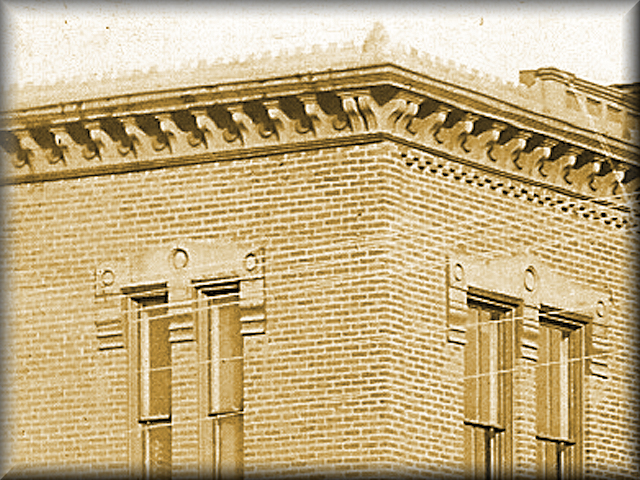cornice

Any molded projection which crowns or finishes the part to which it is affixed; as, the cornice of an order, of a pedestal, of a door, window, or house. — Webster, 1882
 J.H. Carroll received the cornice for the bank building Wednesday from the manufacturer in Sioux Falls. — October 16, 1886, De Smet Leader
J.H. Carroll received the cornice for the bank building Wednesday from the manufacturer in Sioux Falls. — October 16, 1886, De Smet Leader
 Although a cornice is most often thought of as fancy trim around the perimeter of a room at the ceiling or over doors and windows; in building construction, the entire portion of a roof that overhangs the exterior wall is also called a cornice.
Although a cornice is most often thought of as fancy trim around the perimeter of a room at the ceiling or over doors and windows; in building construction, the entire portion of a roof that overhangs the exterior wall is also called a cornice.
In By the Shores of Silver Lake, when Pa is building on the townsite of De Smet in 1880, he doesn’t have time to add exterior siding or to close in the space beneath the eaves prior to the April blizzard, and snow blew in through the large crack left at the top of the exterior wall between the roof joists. There is more detail in manuscript versions than in the published story:
“This place isn’t very warm nor tight, Caroline” Pa said to Ma. “I haven’t had time to put the siding on outside, nor the ceiling on inside and there are no cornices under the eaves to stop that big crack. But we’ll be warm enough now that spring has come and I’ll soon have the building finished.” [snip] Pa put siding on the outside of the building and cornices under the eaves. “Now we’re ship-shape Caroline,” he said. – SSL handwritten manuscript
“This place isn’t very warm, nor tight, Caroline,” Pa said to Ma. “I haven’t had time to put the siding on the outside nor the ceiling on the inside and there are no cornice under the eaves to stop that big crack. But we will be warm enough, now that spring has come and I’ll soon have the building finished.” [and after the April storm:] “This building made a pretty good sieve,” Pa said. “The snow blew through every crack and in under the eaves…” [snip] Pa put the siding on the outside of the building and cornice under the eaves. – SSL manuscript, typed with corrections
“This place isn’t very warm nor tight, Caroline,” Pa said. “I haven’t had time to put on the siding nor to ceil the inside, and there’s no cornice under the eaves to cover that big crack. But we’ll be warm enough, now that spring has come, and I’ll soon get the building finished.” [snip] “This building’s a pretty good sieve!” Pa said. “Snow blew through every crack and in under the eaves. That was a genuine blizzard while it lasted.” -published SSL
Although the cornice isn’t mentioned in Pioneer Girl, the building referred to in the story is the one Pa built (or helped to build) on the corner which became Couse’s Hardware, in use from 1880-1885. Ward’s Store and Bakery is housed in Mr. Couse’s second building on the lot. There are no photographs of this first frame building, but photographs of other original buildings on the site – such as the De Smet Leader building, shown in detail above – suggest that most original town lot frame buildings had only slight roof overhangs (cornice), and the long board on the right along the side of the building is the cornice board Wilder was referring to.
When De Smet businessmen began replacing original buildings with brick ones, some of these were quite elaborately detailed. The photos below show (at left) a portion of the 1912 McKibbon panoramic photo taken from the center of Calumet and Second. The second Charles Ingalls building (where the family lived during the Hard Winter) had been moved to the back of the lot and now faced Second Street instead of what Laura called Main Street (Calumet). John Carroll had built a large brick building, complete with stone cornices. Although the building still stands today (at right), the cornices have been removed.


cornice (SSL 27)

